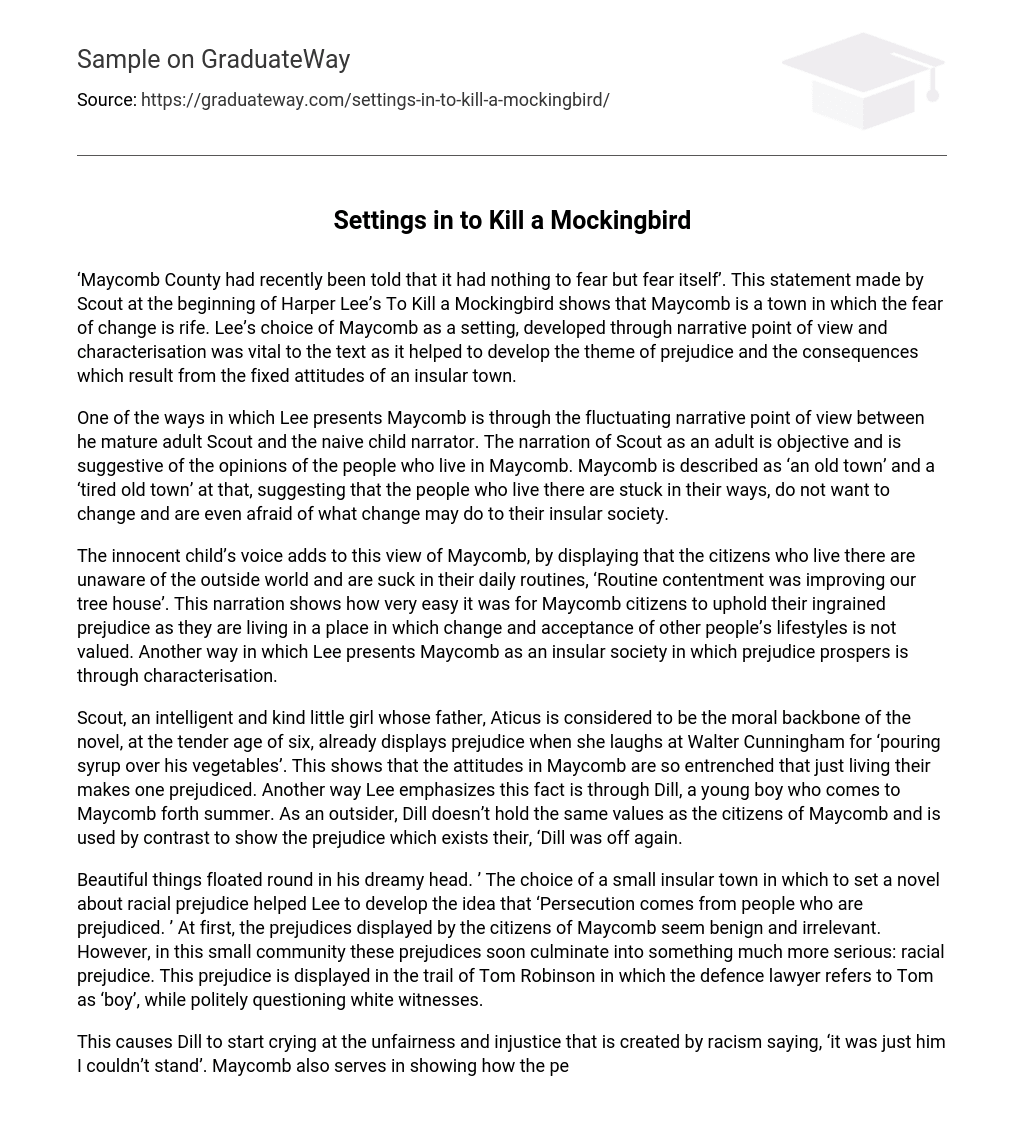‘Maycomb County had recently been told that it had nothing to fear but fear itself’. The statement made by Scout in Harper Lee’s To Kill a Mockingbird suggests that Maycomb is a town that is deeply afraid of change. Lee’s decision to set the story in Maycomb and her development of the setting through narrative point of view and characterisation plays a crucial role in exploring the theme of prejudice and the consequences that arise from the close-mindedness of a small, isolated community.
Lee presents Maycomb through a fluctuating narrative point of view. The mature adult Scout and the naive child narrator provide different perspectives. The adult narration is objective and reflects the opinions of the town’s residents. Maycomb is characterized as an old and tired town, indicating that its people are resistant to change and frightened by the potential impact on their insular society.
The innocent child’s voice contributes to this perspective of Maycomb, indicating that its residents are oblivious to the outside world and are trapped in their everyday routines. The narration reveals that it was effortless for Maycomb locals to maintain their deep-rooted bias because they reside in a community that disregards change and embracing different lifestyles. Lee also portrays Maycomb as an isolated society where prejudice thrives through character development.
Scout, a smart and kind young girl, has a father named Aticus who is seen as the moral center of the novel. Even at the age of six, Scout already displays prejudice when she laughs at Walter Cunningham for pouring syrup over his vegetables. This demonstrates that the attitudes in Maycomb are so deeply ingrained that simply living there leads to prejudice. Another way that Lee highlights this fact is through Dill, a young boy who visits Maycomb every summer. As an outsider, Dill does not share the same values as the people of Maycomb and serves as a contrast to expose the existing prejudice in the town. “Dill was off again.”
In his imaginative mind, he envisaged beautiful thoughts. The decision to set a story about racial prejudice in a small island town allowed Lee to conceive the notion that persecution stems from prejudiced individuals. At the beginning, the biases demonstrated by Maycomb’s inhabitants may appear harmless and insignificant. However, within this tight-knit community, these biases escalate into something more grave: racial prejudice. This bias becomes evident during Tom Robinson’s trial, as the defense attorney addresses Tom as ‘boy’ while courteously interrogating white witnesses.
Dill becomes overwhelmed with sadness and frustration about the unfairness and injustice caused by racism, expressing his disgust towards one particular person by saying, ‘it was just him I couldn’t stand’. Maycomb exposes how racial prejudice leads to the mistreatment of innocent individuals, referred to as ‘mockingbirds’. Tom Robinson is persecuted due to Maycomb’s rigid social hierarchy, where blacks are considered inferior. The persecution of Robinson is not solely based on his skin color but also because he violated one of Maycomb’s social norms by showing empathy and assisting Mayella Ewell – ‘You felt sorry for her?
The citizens of Maycomb found it unacceptable that a black person could feel compassion for a white person. This belief led them to support the unjust treatment of an innocent man, Tom Robinson. His death serves as a stark reminder of Maycomb’s shortcomings as a closed-off community, where there is no willingness to embrace change even when it is desperately needed. Harper Lee intentionally chose Maycomb as the setting for To Kill a Mockingbird to effectively explore the themes of prejudice and the detrimental impact it has on society.
The text encourages readers to think about the possibility of prejudice in their own communities by depicting Maycomb’s society. New Zealand has a multicultural society, making it improbable for a similar injustice to take place here because our nation has accepted diverse cultures and viewpoints. Nevertheless, it is crucial to acknowledge that prejudice against others is natural in humans. In the end, we must remember that all individuals are essentially the same – mere human beings.





